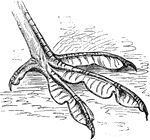Clipart tagged: ‘lobate’

Coot Foot
"Fig. 53 shows the lobate foot of a coot. In the lobate foot, a paddle results not from connecting webs,…

Phalarope Foot
"Fig. 53 bis - shows the lobate foot of a phalarope. In the lobate foot, a paddle results not from connecting…